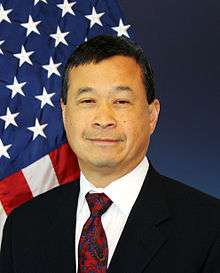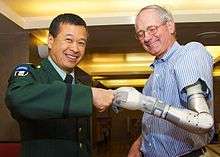Geoffrey Ling
Geoffrey S. F. Ling, M.D., Ph.D., is a medical doctor who retired from the United States Army as a Colonel. He served as the Founding Director of the Defense Advanced Research Projects Agency (DARPA) Biological Technologies Office from 2014 until 2016.[1] He was considered to be the "US Army's premier subject matter expert on traumatic brain injury (TBI)", and was for years the only neuro-intensive care specialist in the US military.[2]
Geoffrey Ling | |
|---|---|
 | |
| Born | Baltimore, Maryland |
| Allegiance | |
| Service/ | |
| Years of service | 1985-2012 |
| Rank | Colonel |
| Battles/wars | War in Afghanistan (2003), Iraq War (2005) |
Prominent in his DARPA research portfolio are Preventing Violent Explosive Neuro Trauma (PREVENT), prevention of explosive blast traumatic brain injury,[3] Revolutionizing Prostheses (RP), development of responsive, brain-controlled, artificial arms, Predicting Health and Disease (PHD), combination of biomarkers and advanced analytics to diagnosis of disease in the presymptomatic state and Battlefield Medicine, development of point-of-care drug manufacturing technology. He also served as a Program Manager and following, the Deputy Director of the Defense Sciences Office. Ling is recipient of the Department of Defense Medal for Distinguished Public Service, Legion of Merit, Alpha Omega Alpha, Sigma Xi and the Humanitarian Award from the Brain Mapping Foundation.[2][4]
Education
Ling earned his BA with honors from Washington University, and earned his doctorate in pharmacology from Cornell University School of Medicine (1982). He completed post doctoral training in Neuropharmacology at the Sloan-Kettering Memorial Cancer Center (1982-1985).[5] In 1989, Ling earned an M.D. from Georgetown University School of Medicine.[3] Both his neurology internship (1989-1990) and later residency (1990-1993) were completed at Walter Reed Army Medical Center. From 1993-1995 Ling had a Fellowship at Johns Hopkins University, Neurosciences Critical Care Unit.[5] At Cornell and Sloan-Kettering, he did opioid research.[6][7]
Professional history
Military
Ling completed two war deployments as a neurointensive care physician: Afghanistan (2003) and Iraq (2005), as well as four "Gray Team" tours to study combat brain injuries.[8][9] His medical studies of the war in Afghanistan and Iraq show that over 50% of those who died of wounds had head injuries.[10]
Prior to his position as the founding Director of the Biological Technologies Office at DARPA, Ling was Professor and Acting Chair of the Department of Neurology at the Uniformed Services University of the Health Sciences (USUHS).[8] He has been on the USUHS faculty since 1995 and is now Emeritus Professor. For many years, he was the Army's only neuro-intensive care physician.[2][11] Ling is also Professor of Neurology and Anesthesiology & Critical Care Medicine at Johns Hopkins Hospital[12] and was a member of the White House Office of Science and Technology Policy (OSTP).[3] Ling served as an Army doctor for 27 years, and retired in 2012. Ling and his work have been featured twice on the TV show 60 Minutes, in 2009 and 2012.[13][14]
Other
Ling is Professor of Neurology and Anesthesiology & Critical Care Medicine at Johns Hopkins Hospital[12] and was a member of the White House Office of Science and Technology Policy (OSTP).[3] Ling and his work have been featured twice on the TV show 60 Minutes, in 2009 and 2012.[13][14] He was also one of the doctors who treated American Congresswoman Gabrielle Giffords after she had been shot in the head.[2] Ling's publications include over 200 peer reviewed journal articles, research reviews, and book chapters[8]

Prosthetic arm development
Because of engineering and medical concerns, arm replacement is more difficult than leg replacement. Arm replacement technology was far behind leg replacement technology when DARPA began the Revolutionizing Prosthetics team in 2006. In May 2014, the US Food and Drug Administration approved the first of the two prosthetic arms developed under that program.[15][16] Earlier in 2014, DARPA's Biological Technologies Office announced the launch of a new Hand Proprioception and Touch Interfaces (HAPTIX) program, which aims to deliver naturalistic sensations to amputees and, in the process, enable intuitive, dexterous control of advanced prosthetic devices; provide the psychological benefit of improving prosthesis "embodiment"; and reduce phantom limb pain. Ling has described the problem of developing a high quality artificial arm as "doggone hard".[17] Ling's Revolutionizing Prosthetics team's work could lead to the restoration of sight and hearing. Using his artificial arms, amputees could precisely move their artificial arms with just thought.[13][14]
Awards
Ling was an "A" designated Army neurologist and is a recipient of the Order of Military Medical Merit.[9] In Toronto, Canada, in 2012, Ling was awarded the Humanitarian Award from the Brain Mapping Foundation.[2][4] He is a Fellow of the American Neurological Association, American Academy of Neurology and the Neurocritical Care Society. Named DARPA Program Manager of the Year (2008), Cornell University Alumnus of the Year (2008) and Washington University Distinguished Alumnus (2015). Is member of Alpha Omega Alpha and Sigma Xi. In 2016, he received the Department of Defense Medal for Distinguished Public Service.
References
- "Geoffrey Ling Bio on DARPA's Biological Technologies Office". DARPA. Archived from the original on 2014-05-23. Retrieved 22 May 2014.
- Abdullah, Stephanie P. (June 13, 2012). "Colonel honored with humanitarian award from the Brain Mapping Foundation for work with TBI". United States Army. Retrieved June 7, 2013.
- "Geoffrey Ling, MD, PhD, Col. (Ret.)". Brain Line Military. 2012. Retrieved June 7, 2013.
- "The Brain Mapping Foundation Awards a US Army colonel and 3 Distinguished U.S. and Canadian Scientists at its Gala in Toronto". PR Newswire. May 29, 2012. Retrieved June 8, 2013.
- "COL Geoffrey Ling". Uniformed Services University of the Health Sciences. July 25, 2012. Archived from the original on June 9, 2013. Retrieved June 7, 2013.
- Ling, Geoffrey; et al. (1981). "Methadone: radioimmunoassay and pharmacokinetics in the rat". Journal of Pharmacology and Experimental Therapeutics. 217: 147–151.
- Ling, Geoffrey; et al. (1984). "Separation of morphine analgesia from physical dependence". Science. 226: 464-464.
- "Dr. Geoffrey Ling Bio". DARPA. Archived from the original on June 17, 2013. Retrieved June 3, 2013.
- "Geoffrey Ling, M.D., Ph.D., FAAN" (PDF). Center for Public-Private Partnerships. Retrieved June 3, 2013.
- Ling, Geoffrey. "Explosive Blast Traumatic Brain Injury" (PDF). Institute of Medicine of the National Academies. Retrieved June 3, 2013.
- "Geoffrey S. F. Ling, MD., Ph.D." National Institute of Neurological Disorders and Stroke. January 24, 2012. Retrieved June 7, 2013.
- "Dr. Geoffrey Ling". The Johns Hopkins University. Archived from the original on June 19, 2013. Retrieved June 5, 2013.
- "The Pentagon's Bionic Arm". CBS News. April 12, 2009.
- "Imagining the Future of Restoration". CBS News. December 20, 2012. Retrieved June 3, 2013.
- Laine, Susan. "FDA allows marketing of first prosthetic arm that translates signals from person's muscles to perform complex tasks". FDA. Retrieved 22 May 2014.
- "From Idea to Market in Eight Years, DARPA-Funded Deka Arm Systems Earns FDA Approval". DARPA. Archived from the original on 12 May 2014. Retrieved 22 May 2014.
- Scudellari, Megan (September 1, 2012). "Missing Touch". The Scientist. Retrieved June 7, 2013.